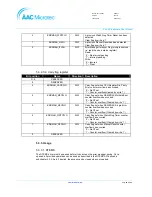
Document number
204911
Version
Rev. K
Issue date
2016-10-11
Sirius Breadboard User Manual
www.aacmicrotec.com
Page
13
of
106
3. Setup
In order to use the toolchain commands, the shell PATH variable needs to be set to
include them, this can be done either temporarily for the current shell via
source /opt/aac/aac-path.sh
or permanently by editing the ~/.profile file
gedit ~/.profile
and adding the following snippet at the end of the file, and then save and close it:
# AAC OR1k toolchain PATH setup
if [ -f /opt/aac/aac-path.sh ]; then
. /opt/aac/aac-path.sh >/dev/null
fi
3.4. Installing the Board Support Package (BSP)
The BSP can either be downloaded from http://repo.aacmicrotec.com/bsp or copied from the
accompanying DVD. Simply extract the tarball
aac-or1k-xxx-x-bsp-y.tar.bz2
to a directory of
your choice (xxx-x depends on your intended hardware target - OBC-S or TCM-s and y
matches the current version number of that BSP).
The newly created directory
aac-or1k-xxx-x-bsp
now contains the drivers for both bare-metal
applications and RTEMS. See the included README and chapter 4.1 for build instructions.
3.5. Deploying a Sirius application
3.5.1. Establish a debugger connection to the Breadboard
The Sirius Breadboard is shipped with a debugger which connects to the PC via USB. To
interface the Breadboard, the Open On-Chip Debugger (OpenOCD) software is used. A
script called run_aac_debugger.sh is shipped with the toolchain package which starts an
OpenOCD server for gdb to connect to.
1. Connect the Breadboard according to section 3.
2. Start the run_aac_debugger.sh script from a terminal.
3. If the printed message is according to Figure 3-2, the connection is working.




























